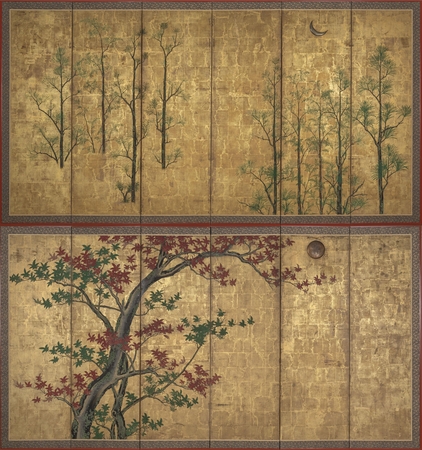Product Description
7740/41 A pair of six-fold paper screens painted in ink and colour on a gold ground, depicting conifers and maple under the moon and the sun, the celestial bodies inlaid in silvered and gilt copper respectively
One screen depicts fresh green hinoki (Japanese cypress) and koyamaki (Japanese umbrella-pine) under the crescent moon; the other depicts kaede (maple) under the sun.
Japan, 18th century, Edo period
Dimensions: H. 151cm x W. 283.5cm (59½” x 111¾”) each
The old wood storage box inscribed:
Lid: Jidai kobyobu nichigetsu hinoki kaede no zu (Early small screens depicting cypress and maple with Sun and Moon)
A paper label: Dai sanbyaku kyuju ban (No. 390) Kinji Momoyama jidai nichigetsu hinoki to kaede (Momoyama-period gold-leaf [screens] depicting cypress and maple with Sun and Moon)
The word hinoki means ‘tree of the Sun’ or ‘tree of spirit’. It has been regarded as a sacred and spiritual tree from ancient times. It was mentioned as an essential architectural material for kami (gods and goddess in Shinto) in Kojiki “Records of Ancient Matters”, a collection of myths about the origin of Japan, kami and Japanese Imperial line, compiled in 712. Hinoki has been used in many sacred building such as shrines and temples since early times.
Maki or Koyamaki (Japanese umbrella-pine) is a unique conifer endemic to Japan and its name comes from the sacred Mount Koya, a huge temple settlement in present Wakayama prefecture. It can be used as an esteemed alternative to flowers offered to Buddha.
Both hinoki and koyamaki have distinguished scents which are believed to remove negative vibrations and purify spirits and have ancient associations with religious rituals. These conifers also remain green and fresh even during winter and are seen as symbols of longevity and vitality.
On the other hand, kaede (maple) shares pride of place with sakura (cherry blossom) as one of the two most important seasonal symbols in Japan. Its changing colours have always captivated the people of Japan and this much admired autumnal motif has been mentioned in poems and literature such as Manyōshū (Collection of Ten Thousand Leaves), Nara period (645-781); The Tale of Genji from the Heian period (782-1184); and the popular Noh play Momiji-gari (Maple Viewing) of the Muromachi period (1392-1572). It is one of the most popular subjects in Japanese paintings and works of art.
Hinoki and koyamaki were one of the favoured subjects by Rimpa School artists. A six-fold screen ‘maki and hinoki’ by Tawaraya Sotatsu (d. c. 1640) is housed in the Ishikawa Prefectural Museum of Art. A 17th-century six-fold screen depicting maple and makiattributed to Sotatsu is housed in the Yamatane Museum of Art. A two-fold screen with hinoki by Ogata Korin (1658-1716) is housed in the Tokyo National Museum (item number A-10144).
A comparable depiction of maki can be found in a set of fusuma (sliding doors) painting in Nagoya Castle (1614, Important Cultural Property), which depicts maki, maple and camellia. See Kyoto Natioal Museum, The 100th Anniversary of the Kyoto National museum Special Exhibition: The Age of Gold, The Days of Dreams – in praise of the paintings of the Momoyama period, (Japan, 1997), p. 312-313, no. 72.
The sun and crescent moon have been occasionally depicted on pairs of screens in Japan and a few early examples took the form of metal attached to the screen in a similar manner.
In two screens ‘Landscapes with the Sun and the Moon’ (16th century, Muromachi period) in the Tokyo National Museum (Important Cultural Property, item number A-1065), the sun and the moon are represented by gold-plated and silver-plated metal sheets respectively. See Tokyo National Museum et.al. eds., Screen Paintings of the Muromachi Period: A Special Exhibition Held to Commemorate the 100th Anniversary of Kokka Magazine, (Tokyo, 1989), p.62-63, no. 14.
For another comparable example, a pair of screens ‘Birds and Flowers of the Four Seasons with Sun and Moon’ (16th century, Muromachi period) housed in the Idemitsu Museum, Tokyo, see Id. p.38-41, no. 7.; Suntory Museum of Art et.al. eds., Biombo: Japan Heritage as Legend of Gold, (Japan, 2007), p.55-57, pl.7.
A six-panel screen depicting willows and Uji bridge housed in the Metropolitan Museum of Art, NY, bears a waxing moon in copper (early 17th century, Momoyama period, Mary Griggs Burke Collection, Accession Number: 2015.300.105.1, .2).









